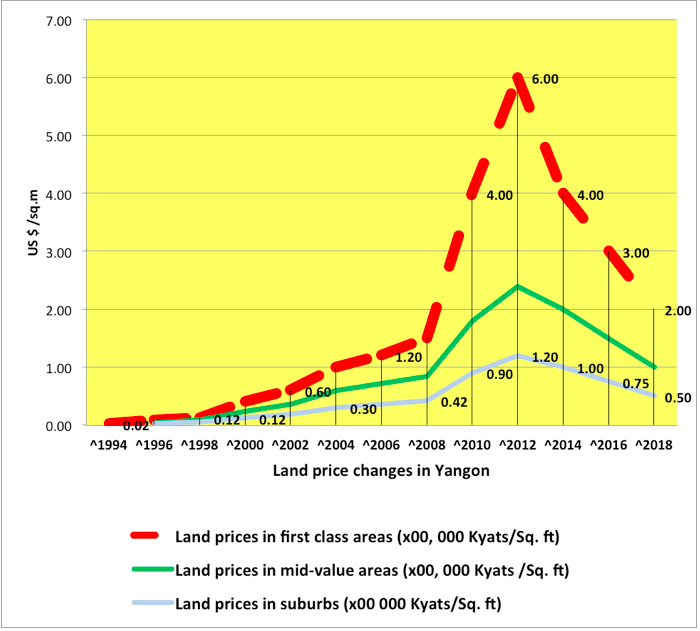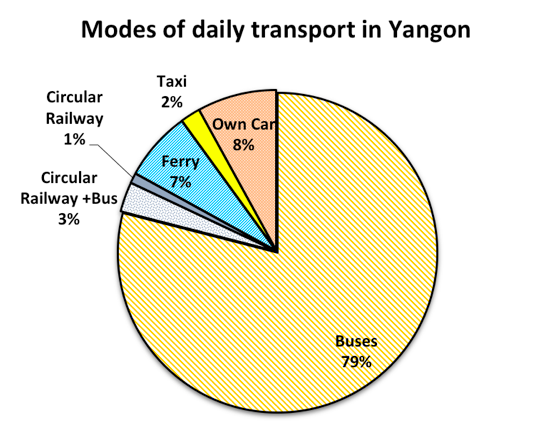In 1988, Yangon measured about 80 sq. miles (around 207 sq. km). The city has grown in the three decades since then and now covers more than 300 sq. miles (777 sq. km). The author of this article has been in the urban planning field for around 50 years and has never come across another city that has more than tripled in size within such a short period. However, the authorities in Yangon are planning to expand the city further by building the “New Yangon City project.” A few questions regarding the project are justified, such as:
- Are we in need of more land for our present and future activities? For example, for industries, commercial activities, etc.?
- Are land and apartment prices in Yangon soaring so much that we need to develop new areas around Yangon?
- Is Yangon’s infrastructure, such as water supply, sewage and drainage, road networks, etc., satisfactory and functioning well?
Obviously, these major issues confronting Yangon should be addressed when planning the new city. The following are some relevant facts and figures:
- The Yangon City Development Committee (YCDC) supplies the city with over 200 million gallons of water daily, which should be more than sufficient for Yangon’s 5.2 million people, assuming a rate of 30 gallons per person per day, the standard for Myanmar’s upper income brackets. However, only 330,000 out of Yangon’s 1.1 million households (or 28 percent) are connected to the city’s water supply; the rest get water from various sources, mostly from underground. It is a known fact that over-extraction of underground water has negative consequences.
- In the case of the electricity supply, around 660,000 homes (or 61 percent) are connected to the power grid and have meter boxes (based on data from 2014).
- Approximately 50 percent of the land area in Yangon is prone to flooding during heavy rains; this is not only an inconvenience, but also a health hazard.
- To improve this situation is imperative; many areas have no proper drainage system and many areas do not even have drainage maps. This situation can only be alleviated by creating an overall drainage master plan for the whole city.
- In terms of sewage and domestic wastewater, 7 percent of households in the seven townships that comprise Yangon’s central business district (CBD) are attached to the central sewer system, 65 percent use septic tanks or fly-proof latrines; and 29 percent use unsanitary disposal systems (based on data from 2014).
- In terms of solid waste disposal, all collected solid waste is dumped on garbage heaps; there is no system of incineration or any kind of treatment or energy extraction from the solid waste.
- According to the YCDC’s 2014 survey, 85 percent of daily commuters in the city use buses, 8 percent use their own cars, and 5 percent use trains. Thanks to the city authorities of the 1950s, Yangon is fortunate to have a circular rail line, though it is presently not fully utilized. To reduce travel time, pollution and energy, the proportion of commuters using the railway should be increased several fold. (In most cities of comparable size, rail usage is over 50 percent.)
- Of some 3.5 million daily commuters, around 30 percent must spend more than three hours a day traveling. Added to an eight-hour working day, this leaves breadwinners spending 11 hours or more away from their families. This can cause social estrangement and damage family ties.
- For historical reasons, 46 percent of all commercial and cultural establishments in Yangon are located in the CBD or areas close to it, like Bahan, Kyimyindaung, Sanchaung, etc. This zone accounts for just 10 percent of the city’s total area. Because of this land-use pattern, this high-density commercial zone is the destination for 43 percent of all daily commuters. The main cause of traffic congestion and slow traffic movement is this monocentric use of land. Urban planners and traffic experts have long recommended gradually diversifying this land-use pattern and planning multiple sub-centers in peripheral areas.
- An associated reason for traffic congestion is the sectorial distribution of the labor force in Yangon. Of the city’s work force, 11 percent is employed by the government sector, 80 percent by the tertiary sector (trading and services) and only 9 percent by the industrial sector. This high percentage of tertiary sector employees contributes to the abundance of roadside vendors and also to the traffic problems.
- Regarding industrial development, the city has around 20,000 industrial plots, only 60 percent of which are occupied and being used. One company has a monopoly on these plots, which it sells for around 600 million kyats per plot. Including infrastructure, one plot can cost around 800 million kyats or around US$600,000 dollars.
- Research shows that the average investment for a factory employing 700-1,000 workers (for example garment, furniture or other low-tech factories) is between US$1 million and 2 million. This foreign investment-to-land cost ratio of around 2:1 is one important factor hampering the investment flow into the industrial sector in Yangon and in Myanmar in general.
- Yangon has a very uneven population distribution; the old areas with relatively good infrastructure have population densities ranging from 10,000 to 50,000 people per sq. mile, while the newly developed, poorer areas range between 7,000 and 15,000. Some 40 percent of Yangon’s population lives in these poor, low-standard areas. This uneven population distribution contributes to traffic and transportation problems, as well as social segregation.
- In terms of land requirements, since 1988 around 200 sq. miles, or around 120,000 acres (around 500 sq. km), have been integrated into the city area in the form of town extension projects. Around 17,000 acres in the north-eastern part of the city are still vacant, and there are a few thousand acres assigned to some private companies that are also unused.
- These vacant areas are all in good locations close to Minglardon Garden City, the circular railway line and on the main highway to the planned Hanthawaddy Airport. Development of these areas means no additional loss of agricultural land and no additional cost for bridges and access roads.
- Concerning land and apartment prices, Yangon has never had a stable market; fluctuations have been frequent, but since 2014 they have been in decline (see Fig. 1).


Of all the arguments made for or against the city expansion project, the most important is “to promote national harmony and unity.” Yangon had a population of 5.2 million in 2014, four times larger than Myanmar’s second-largest city, Mandalay. Yangon Region has the highest per capita GDP in the Union, and in terms of health care, employment and education facilities, the population of Yangon enjoys the best the Union has to offer. But what are the ramifications of this disparity and inequality between regions for national unity and the Union’s long-term future?
Authorities expect about 2 million people to work in New Yangon City, implying a total population of around 8 million. Including Yangon’s existing population of around 5 million and accounting for natural growth, this would create a gigantic urban conglomeration with a population of around 14-15 million.
Since World War II, planned towns and extension schemes have appeared worldwide, including Chandigarh in India (present population around 1 million), Brasilia in Brazil (2.5 million), Islamabad in Pakistan 1 million, and Putrajaya in Malaysia (designed for a population of around 200,000). The present plan for New Yangon City exceeds all of these in terms of population size and targeted employment. This is an issue of national concern and requires more thorough and comprehensive investigation and the conducting of feasibility studies. Above all, this scheme requires approval by parliamentary and executive authorities at multiple levels. After this approval phase, cooperation and assistance from Union ministries with specialized knowledge and experience in this field will be necessary from the planning stage.
Dr. Kyaw Lat is an architect and urban planner with work experience in the Department of Human Settlements and Housing Development, Ministry of Construction, United Nations Center for Human Settlements (Habitat), as a professor at Yangon and Mandalay Technological universities, as a professor at Cologne University of Applied Sciences, Germany, and finally before his retirement, as the adviser to the Yangon City and Development Council from 2011 until 2016.

















